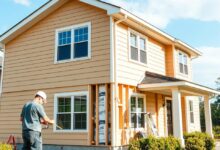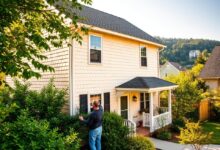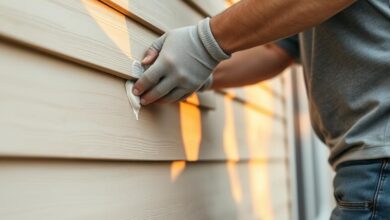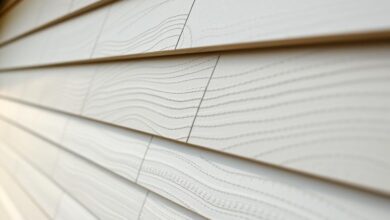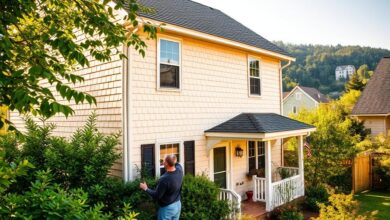Upgrade Your Home with Vinyl Insulated Siding
Looking to make your home more energy-efficient and attractive? Think about getting vinyl insulated siding. It makes your home look better and keeps it safe from the weather.
Choosing vinyl insulated siding can cut down your energy costs. It’s strong and can handle tough weather, so you won’t need to fix it often.
Many people are choosing vinyl insulated siding for their homes. It’s great for saving energy or just giving your home a new look.
Key Takeaways
- Enhances home’s energy efficiency
- Durable and long-lasting
- Reduces energy bills
- Boosts curb appeal
- Withstands harsh weather conditions
What Is Vinyl Insulated Siding?
Vinyl insulated siding is a modern exterior solution. It combines durability with energy efficiency. It’s designed to give a strong exterior finish and reduce heat transfer between inside and outside.
The Structure and Components
Vinyl insulated siding has two main layers. The vinyl exterior is durable and easy to maintain. The insulating backing, made of expanded polystyrene (EPS) or polyisocyanurate (PIR), boosts the siding’s thermal performance. This makes the siding protect the home and help save energy.
How It Differs from Standard Vinyl Siding
Vinyl insulated siding has an extra layer of insulation. This makes it more energy-efficient than standard vinyl siding. Standard vinyl siding is mainly for looks and basic protection. Vinyl insulated siding, on the other hand, offers better thermal insulation. It helps keep homes cooler in summer and warmer in winter, saving on utility bills and making homes more comfortable.
Key Benefits of Vinyl Insulated Siding for Homeowners
Vinyl insulated siding is changing the game for homeowners. It boosts energy efficiency and looks great. It’s a top pick for those wanting to improve their homes.
Energy Efficiency and Utility Savings
Vinyl insulated siding makes homes more energy-efficient. It adds insulation, cutting down on heat loss in winter and heat gain in summer. This means lower utility bills.
The U.S. Department of Energy says homeowners can save up to 15% on energy costs. This is thanks to better insulation.
- Reduces heat transfer through the walls
- Minimizes air leakage
- Lowers heating and cooling costs
Durability and Weather Resistance
Vinyl insulated siding is tough and can handle harsh weather. It doesn’t crack or fade like regular vinyl siding. CertainTeed says it’s built for long-lasting performance.
Noise Reduction Properties
Vinyl insulated siding also cuts down on outside noise. The insulation layer absorbs sound, making homes quieter. This is great for homes in noisy areas.
“The added insulation in our siding has made a significant difference in reducing outside noise. It’s like having a whole new house!”
Choosing vinyl insulated siding means a quieter, more energy-efficient home. Its many benefits make it a favorite among homeowners.
Top Vinyl Insulated Siding Products on the Market
Vinyl insulated siding is now more popular than ever. Top brands offer durable and energy-saving products. Homeowners can choose from many high-quality options to improve their home’s look and save energy.
CertainTeed Monogram Insulated Siding
CertainTeed’s Monogram Insulated Siding stands out for its durability and good looks. It combines foam insulation with a strong vinyl exterior.
Features and Specifications
This siding has a multi-layer design for better insulation and weather resistance. It comes in various colors and styles to fit different homes.
Pros and Cons
The benefits of CertainTeed Monogram include its high R-value, durability, and easy upkeep. But, it might cost more than other options.
Mastic by Ply Gem Structure Insulated Siding
Mastic by Ply Gem offers strong, weather-resistant insulated siding. Their Structure Insulated Siding is built to last and save energy.
Features and Specifications
This product has a foam backing for great insulation. It’s also made to resist impact and extreme temperatures.
Pros and Cons
Mastic by Ply Gem’s Structure Insulated Siding is durable and energy-efficient. Some might find it harder to install than other products.
Norandex Polar Wall Plus Insulated Siding
Norandex Polar Wall Plus Insulated Siding is known for its quality and performance. It combines insulation with durability.
| Product | R-Value | Durability | Price Range |
|---|---|---|---|
| CertainTeed Monogram | High (R-4.3) | Excellent | Premium |
| Mastic by Ply Gem | High (R-4.0) | Excellent | Premium |
| Norandex Polar Wall Plus | High (R-3.8) | Very Good | Moderate to Premium |
When picking vinyl insulated siding, think about energy savings, durability, and cost. The products mentioned are top choices, each with special features and benefits.
Cost Analysis of Vinyl Insulated Siding
Homeowners need to think about the cost of vinyl insulated siding before deciding. It has many benefits, but the price is a big factor.
Initial Installation Costs
The cost of vinyl insulated siding is higher than other siding types. Installation costs depend on the home’s size, installation complexity, and location. On average, it costs between $10 and $15 per square foot, including labor and materials.
Here’s a cost comparison of different brands:
| Brand | Cost per Square Foot | Installation Cost for Average Home |
|---|---|---|
| CertainTeed Monogram | $12 | $15,000 – $18,000 |
| Mastic by Ply Gem | $11 | $13,750 – $16,500 |
| Norandex Polar Wall Plus | $13 | $16,250 – $19,500 |
Long-term Savings and ROI
Even though it costs more upfront, vinyl insulated siding saves money in the long run. It cuts down on energy bills by reducing heat loss in winter and heat gain in summer. Homeowners can see a return on investment (ROI) of up to 80% when they sell their home.
Financing Options and Tax Incentives
There are many financing options to help make vinyl insulated siding more affordable. Homeowners can use home equity loans or government-backed programs. They might also get tax incentives, if the siding is part of a bigger energy-saving project.
Aesthetic Options and Customization
Vinyl insulated siding is a favorite among homeowners for its beauty and flexibility. It offers a wide range of choices, letting homeowners personalize their home’s look. This way, they can match their style and taste perfectly.
Available Colors and Textures
Vinyl insulated siding comes in many colors and textures. Homeowners can pick the perfect match for their home’s design. Popular colors include earth tones, grays, and whites. Textures range from smooth to woodgrain finishes.
Architectural Styles and Compatibility
Vinyl insulated siding fits many architectural styles. It works well with both traditional and modern homes. Whether your home is classic or modern, vinyl siding can be customized to match.
Accent and Trim Options
Vinyl insulated siding can be paired with various accents and trims. Decorative trim and corner posts add elegance. Soffit and fascia options help create a unified look.
Installation Process and Considerations
Installing vinyl insulated siding can make your home more energy-efficient and look better. Homeowners need to know the details of the installation process.
DIY vs. Professional Installation
Choosing between DIY or professional installation is a big decision. DIY can save money but needs a lot of siding knowledge. Professionals ensure the siding is put in right and avoid future problems.
Preparation Requirements
Before starting, several steps are important. Check the home’s exterior for damage or rot. Remove old siding if needed. Make sure walls are level and strong. Good preparation leads to a successful installation.
Timeline and What to Expect
The time it takes to install vinyl insulated siding varies. It depends on the home’s size and job complexity. Professionals usually finish in a few days to a couple of weeks. They start by preparing the site, then remove old siding, and install the new one.
| Installation Aspect | DIY Considerations | Professional Installation Benefits |
|---|---|---|
| Cost | Potentially lower upfront costs | Warranty and long-term savings |
| Time | Significant time commitment | Faster completion due to expertise |
| Quality | Dependent on homeowner’s skill level | High-quality results guaranteed |
Understanding the installation process helps homeowners make smart choices. This ensures a successful siding project that boosts your home’s value and efficiency.
Maintenance and Care Tips
Keeping your vinyl insulated siding in good shape is important. Regular care helps it look great and work well.
Routine Cleaning Methods
Cleaning your siding often is key to avoiding damage. Use a soft brush or a garden hose with a spray nozzle. For tough stains, a soap and water mix works well.
Dealing with Damage and Repairs
Fixing siding damage quickly is vital. For small issues, a vinyl repair kit can help. But for bigger problems, get a pro’s help.
Extending the Lifespan of Your Siding
To make your siding last longer, avoid harsh chemicals and rough cleaners. Regular checks can spot problems early.
| Maintenance Task | Frequency | Benefits |
|---|---|---|
| Cleaning | Every 6 months | Removes dirt and debris, preventing damage |
| Inspection | Annually | Identifies problems early |
| Repair | As needed | Fixes damage, stops further wear |
Conclusion: Is Vinyl Insulated Siding Right for Your Home?
Exploring vinyl insulated siding shows it has many benefits for homeowners. It saves energy, lasts long, and reduces noise. These features make it a great choice for improving your home’s look and saving on bills.
Think about the upfront costs and long-term savings when choosing vinyl insulated siding. Brands like CertainTeed, Mastic by Ply Gem, and Norandex have quality options. They fit different tastes and home styles.
Vinyl insulated siding is good for those who want energy savings, durability, and easy upkeep. Knowing how to install, maintain, and customize it helps you decide if it’s right for your home.




